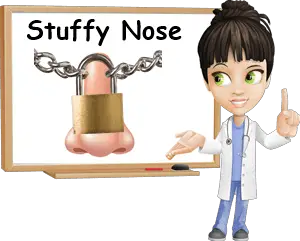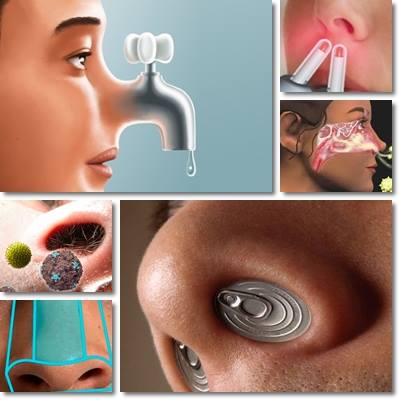Having a stuffy nose is not necessarily a medical emergency for the average person, but the utter discomfort that comes with it can make it a truly nerve-racking experience.
Nasal congestion is often a symptom of a viral or bacterial infection, but is also frequently caused by allergies such as hay fever or various pollen allergies. More serious underlying causes are generally accompanied by more specific symptoms.
It is important to keep in mind that a stuffy nose is only a temporary inconvenience. Treating it depends on knowing what has caused it in the first place and understanding that there isn’t any miracle solution to clearing congestion right away and for good.
We will have to be patient and give our body time to respond to treatment. Eating right and staying hydrated throughout the whole time we experience nasal congestion is vital for a fast and good recovery.

What is a stuffy nose?
A stuffy nose goes by many names: nasal congestion, blocked nose, plugged nose etc. It occurs when blood vessels in the lining of our nose get irritated and inflamed, causing the lining to swell and obstruct normal breathing. As a response to inflammation and to help fight infection, extra mucus is secreted and this contributes further to accentuating the ‘stuffy’ nose sensation. Mucus in the nose protects the sensitive nose lining by maintaining moisture and traps bacteria and viruses.
What causes nose stuffiness?
Treating a stuffy nose can be done most efficiently when we know what has caused it. Read on and find out what are the most common 10 causes of nasal congestion:
1) Common cold or the flu (influenza).
2) Sinus infections and other upper respiratory infections.
3) More severe respiratory infections (example: bronchitis).
4) Allergies (various pollen allergies, hay fever, dust allergy or allergy to cleaning products, smoke, smog, mold).
5) Sensitivity to low temperatures (sudden cold weather).
6) Dry air (dries out and irritates the nostrils mucosa).
7) Rhinitis medicamentosa (rebound nasal congestion caused by prolonged use of nasal decongestant sprays).
8) Other medication: birth control medication, hypertension medication, antibiotics etc.
9) Pregnancy (causes increased blood flow which can lead to symptoms such as changes in blood pressure, dizziness, nasal congestion, nosebleeds, bleeding gums).
10) Structure-related causes: nose polyps, deviated septum etc.

Other symptoms Related To Stuffy Nose
As mentioned above, nasal congestion is nothing more than a symptom and may appear either alone or in combination with other signs and symptoms as follows:
1) Stuffy, runny nose and sneezing.
2) Stuffy nose, red, itchy, watery eyes and dry, itchy ears and nose.
3) Stuffy nose and sleepiness, lightheadedness, dizziness and low energy levels.
4) Stuffy nose and postnasal drip (thicker than usual mucus gathering in the back of our nose and dripping down our throat).
5) Stuffy nose and sore throat, possibly from a respiratory infection.
6) Stuffy nose and cough, likely caused by a respiratory infection.
7) Stuffy nose and blocked hearing, indicates tonsils or ear infection.
8) Stuffy nose and sinus pressure or headaches.
9) Stuffy nose, sniffing and fever, likely infectious cause.
10) Stuffy nose and loss of smell – infection or allergies.
11) Stuffy nose and snoring, wheezing, sleep apnea and difficulty breathing through the nose.
Stuffy nose and allergies
A stuffy and runny nose accompanied by sneezing is often a sign of allergies such as hay fever, allergies to pollen in general, dust, mold, smog, smoke, pet hair allergies or allergies to chemicals in cleaning products, body, face or hair products.
Red, itchy, dry or watery eyes and itchy nose and ears may occur as well. Some people also experience sleepiness, lightheadedness, headaches, sinus pressure and postnasal dripping along with nasal congestion.
Symptoms may vary from person to person. For example, I experience stuffy nose, thick, clear mucus dripping in my throat and strong feelings of sleepiness throughout spring whenever I am close to certain plants I am allergic to.
As soon as I get to a certain distance, symptoms subside, but my nasal congestion lasts up until I wash my face and hair and change my clothes (this helps remove any remaining allergens). Also see difference between allergy, cold, flu and sinus infection.
Stuffy nose and respiratory infections
Nasal congestion accompanied by sniffing, sore throat, sinus pressure and pain, fever, coughing, headaches or visible changes in mucus color may indicate the onset of a viral or bacterial infection (cold, flu and so on). Loss of smell can be a result of a respiratory infection too, but may occur as a side effects of certain medication (antibiotics, for example).
Stuffy nose and postnasal drip
A stuffy nose dripping in the throat (called a postnasal drip) can also irritate the sensitive throat mucosa and lead to coughing, hoarseness and a sore throat. Too much mucus going down our throat can block our ears and muffle our hearing, potentially causing an ear infection or otitis.
This occurs because the Eustachian tube in our middle ear is connected to our throat. Postnasal drip can be a result of a bacterial or viral infection, but can very well be caused by allergies, swallowing difficulties or acid reflux.
Other. Snoring, wheezing, difficulty breathing both when awake and when asleep, may indicate conditions such as nasal polyps, deviated septum etc. A visit to a specialist is required for diagnosis and treatment.
See a doctor immediately if you experience any of the following symptoms:
1) Condition does not improve over the course of a week.
2) You experience nosebleeds or notice blood in postnasal drip.
3) Mucus changes color (dark yellow, green, dark red mucus colors).
See what different nose mucus colors mean.
4) Mucus has a bad odor.
5) You experience fever or fever does not break.
Important: Newborns and young children are risk categories and should be under medical supervision if they experience nasal congestion. Antibiotics are only necessary when there is a bacterial infection and this is best diagnosed by a medical professional.
Non-steroidal anti-inflammatory medicines for fever and sinus pain relief should only be taken according to your doctor’s recommendation.
Treatment options For Stuffy nose
Treating a stuffy nose depends on what has caused it in the first place. Fortunately, there are several remedies we can all rely on to help us clear a stuffy nose:
1) Keep hydrated
Whether we have a stuffy nose because of allergies or a respiratory infection, drinking plenty of water, herbal teas and even natural juices can help considerably. Liquids keep us hydrated and help maintain mucous membranes soft which, in turn, helps reduce irritation and makes mucus more fluid.
Moreover, the more liquids we drink, the easier it is for excess mucus to be expelled, relieving nasal congestion.
2) Take a hot shower
The steam released during a 15-20 minute hot shower can help clear a stuffy nose efficiently. Whenever I have a really bad cold, I take a hot shower right before bed because my stuffy nose tends to become worse in the evening.
I feel this helps flush out any thick mucus blocking my nose and keeps my nasal passages moist enough to allow me to fall asleep and rest for several hours uninterrupted.
3) Breathe steam from a pot
Some people just don’t like getting wet or feel too exhausted to hop in the shower when down with a really bad cold, for example. Breathing steam from a pot of hot water can have the same therapeutic effects of taking a hot shower. Simply fill a large pot with water and bring it to a boil. Then place a towel over your head and lean over the pot to breathe the warm steam.
This should help relieve some of the congestion and contribute to keeping the nasal passages moist. Some prefer adding peppermint tea bags or peppermint or eucalyptus essential oil to the water for a stronger effect.
4) Irrigate the nasal passages
This can be done with a syringe, a Neti pot or a special nasal irrigator and saline solution (sterile water and salt). Irrigating the nasal passages is said to help clear mucus, bacteria, allergens, relieve stuffiness and moisturize the nasal mucosa.
For me, nasal irrigation is bothersome so I prefer washing my face with lukewarm water several times a day and use saline solution nasal sprays with aloe vera or other herbs for the same effect.
5) Use a humidifier or vaporizer
This should help preserve moisture in the room and prevent the nose from drying out which, in turn, will promote decongestion naturally and help with stuffy nose both in the evening and in the morning (because that is when the symptoms are worst).
6) Keep your head elevated when sleeping
Use 2-3 pillows to support your upper back, shoulders, neck and head and keep your head slightly higher than the rest of your body. This should prevent your nose from getting stuffy and allow you to get some rest because, as we all know it, our nose tends to get particularly stuffy in the evening.
As for nasal decongestants, you should rely on them as little as possible because they can easily lead to a rebound, dry out the nose, cause bleeding and further discomfort. Just stay strong and think that it doesn’t matter if you don’t get any sleep tonight because you’ll get your chance when your nose clears. Staying hydrated, eating well, taking your vitamins and simply enjoying bed rest will help you get through your stuffy nose ordeal.
